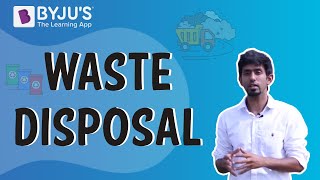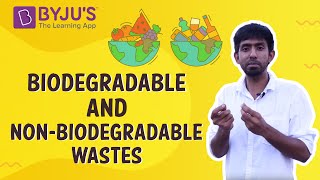Most human activities produce waste, which is unavoidable. The Asian and Pacific Region’s economic progress and growing living standards have increased the quantity and complexity of data industrial diversification and waste generation. The construction of new health-care facilities has a significant amount of industrially dangerous waste into the waste stream, trash and biological waste having significant environmental and human consequences and health ramifications.
| Definition: Any substance that is thrown after its primary purpose or is worthless, faulty, or useless is considered waste. |
Waste Chemistry Questions with Solutions
Q-1: Give one word for the following:
- Liquid waste released from industries
- A process for removing pollutants
- Network of big and small pipes carrying sewage
- A disinfectant for water
- A way suspended microbes settle at the bottom of the tank in sewage treatment
Answer:
a) Sewage
b) Cleaning of water
c) Sewers
d) Chlorine
e) Activated Sludge
Q-2: List the types of impurities present in sewage.
Answer: Sewage is a complicated mixture of
1.Suspended materials
2.Organic and inorganic pollutants that includes fruit and vegetable waste, nitrates, phosphates etc,
3. Nutrients like nitrogen and phosphorus
4. Disease-causing bacteria
5. Saprophytes
Q-3: Which of the following is a bacteria causing typhoid?
- Vibrio cholera
- Salmonella
- Protozones
- None of the above
Answer: b) Salmonella
Explanation:
Typhoid fever is a disease that is spread via contaminated food and water. Bacterias responsible for it are Salmonella and Paratyphi .
High temperature, headache, stomach pain, weakness, vomiting, and loose stools are some of the symptoms.
Antibiotics and fluids are used in treatment.
Q-4: Define the following.
- Vermicomposting
- Compost
- Chemical waste
Answer:
- Vermicomposting: It is a process of making compost with the help of redworms.
- Compost: A soil fertiliser and conditioner made primarily of decomposed organic materials.
- Chemical waste: A waste formed from hazardous chemicals that are typically produced in large industries.
Q-5: Which waste can be decomposed with the help of red worms?
- Coffee and tea remains
- Polythene
- Nails
- Broken toys
Answer: a) Coffee and tea remains
Explanation: The red worms do not convert cloth, polythene bags, shattered glass, aluminium wrappers, nails, or broken toys into compost.
It can convert only biodegradable garbage such as vegetable and fruit waste, weeds from the gardens or coffee and tea remains.
Q-6: Comment whether the statement is true or false:
Earthworms are called a farmer’s friend.
Answer: True
Explanation:The reason for this is because earthworms boost soil fertility by increasing the quantity of air and water that enters the soil, allowing for better aeration and drainage. They transport organic materials down from the upper levels of the ground and mix it with the soil below, boosting nutritional availability. Farmers have long desired to cultivate their crops in fertile soil. Earthworms perform this service for free. They are truly assisting farmers. They cause the dead biological stuff to fragment.
Q-7: Explain the four major types of waste along with examples.
Answer:
- Municipal solid waste: Households, offices, hotels, stores, schools, and other institutions generate municipal solid waste (MSW). Food trash, paper, plastic, rags, metal, and glass are the main examples..
- Industrial Solid waste: These are the byproducts of factories and industries. Most industries throw their trash into rivers and seas, polluting the environment. Plastic, glass, housekeeping wastes, packaging, food wastes, construction and demolition materials are some examples.
- Agriculture waste and Residue: Agricultural waste is characterised as undesirable waste generated by agricultural activities. Examples:manure, oil, silage plastics, fertiliser, pesticides, and herbicides.
- Hazardous waste: Hazardous waste is defined as waste that poses a significant or possible risk to human health or the environment. Example: Explosives, Toxic gases etc.
Q-8: What is meant by the term “Landfill”?
Answer: A landfill is a location where rubbish from a city or town is dumped. Later, the area is transformed into a park.
Q-9: What can we do to reduce our reliance on plastics and deal with waste?
Answer:
1. At home, we utilise vermicomposting to recycle our kitchen trash.
2. We do not discard plastic bags after they have been used.
3. We require store owners to use paper bags. When we go shopping, we bring a cloth or jute bag with us.
4. We write on both sides of the paper. For rough work, we use a slate.
5. We use as little plastic bags as possible. We reuse the bags whenever it is practicable to do so without causing harm.
Q-10: Fill in the blanks
(a) Activated sludge is about ____________ percent water.
(b) ____________ bacteria causes cholera.
(c) Dried ___________ is used to replenish the soil with organic matter and nutrients.
(d) ____________ was initiated by the government in 2016 to provide toilets to everyone.
(e) _______ sewage disposal systems are being promoted to improve sanitation.
Answers:
- 97
- Vibrio cholera
- Sludge
- Swachh Bharat
- On site
Q-11: Which great leader of India said the statement “No one needs to wait for anyone else to adopt a humane and enlightened course of action.”
- Jawaharlal Nehru
- Bhagat singh
- Mahatma Gandhi
- Vallabhbhai Patel
Answer: c) Mahatma Gandhi
Q-12: What is the purpose of a vermi processing toilet?
Answer: In India, a toilet design that uses earthworms to treat human waste has been tried. It was discovered to be a revolutionary, low-water-use toilet for safe human waste processing. The toilet is extremely easy to use and maintain. Human waste is entirely transformed into vermi cakes, a valuable soil resource.
Q-13: Why is it recommended that eucalyptus trees be planted everywhere along sewage ponds?
Answer: These trees quickly absorb any excess wastewater and emit clean water vapour into the atmosphere.
Q-14: Make a distinction between biodegradable and non-biodegradable waste.
Answer:
| Biodegradable Waste | Non Biodegradable Waste |
| It is a natural waste | It is a synthetic waste |
| Are safe to the environment | Harmful to the environment |
| Decomposition rates for biodegradable materials are high. | Decomposition of non-biodegradable compounds is gradual. |
| These compounds naturally degrade in the environment. | These compounds do not degrade naturally in the environment. |
| Vegetable wastes, dead plants, dry leaves, animal excreta, and other materials are examples. | Rubber, chemicals, polythene, metals, and other materials are examples. |
Q-15: Explain how ragpickers contribute to waste disposal.
Answer: Rag Pickers collect trash such as plastic, glass, and old newspapers from open dumping locations and deliver it to recycling centres. They can support themselves while also helping to clean up the environment.This helps to reduce the amount of waste produced.
Practise Questions on Waste Chemistry
Q-1:What exactly do you mean when you say fatberg? How can you get rid of it?
Q-2: Briefly describe the following terms:
- Refuse
- Sewage
- E-waste
Q-3: Pits X and Y were dug separately. Material A was placed in pit X, and material B in pit Y. The earth had covered both pits. When they were pulled up after a month, it was discovered that substance A had stayed intact, whereas material B had entirely rotted.
- A and B are what kind of materials?
- What exactly are Materials A and B?
- What is the cause of material B’s rotting?
Q-4: Discuss two ways to improve your housekeeping so that waste and pollution are reduced or eliminated.
Q-5: How can sickness be avoided with sanitation?
Click the PDF to check the answers for Practice Questions.
Download PDF
Recommended Videos
Waste Disposal

Biodegradable And Non Biodegradable Wastes

Comments